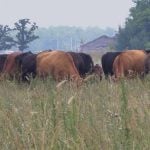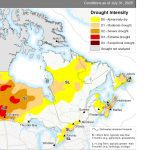This is the Canadian Food Inspection Agency’s regulation:
WINNIPEG — It’s crystal clear to Gunta Vitins why Canadian organic food producers and processors should be worried about natural food.
Public opinion surveys indicate that 60 percent of Canadians believe in and rely on the word “natural” when making food purchases, yet only 45 percent of Canadians put their faith in the word “organic.”
Vitins, who runs Vitins Consulting in Vancouver and has worked in Canada’s organic sector for many years, said there is a big problem with this emphasis.
“Natural means nothing,” she told the Canadian Organic Science conference held last month in Winnipeg.
Read Also

Alberta eases water access for riparian restoration
Alberta government removes requirement for temporary diversion licence to water plants up to 100 cubic metres per day for smaller riparian restoration projects
It’s difficult to put numbers on the impact that the natural brand has had on organic sales in Canada, but it’s clear industry leaders believe natural foods are undercutting sales of organic products and have been for a while.
“That (natural) is having the greatest impact on the demand for your (organic) product right now and the value you receive,” Tom Cowell, general manager of Growers International Organic Sales, an organic grain merchandiser based in Winnipeg, said in 2010.
Mathew Holtmann, owner of Vita Health stores in Winnipeg, said natural and local beef is now more appealing to his customers than certified organic beef.
The curb appeal of the natural brand means Canadian producers can forgo organic certification and still receive a price premium if they sell their meat and vegetables under the natural banner.
“We’re seeing the greenwash of natural in the marketplace, usually marketing itself a couple of price points below organic,” said Matt Holmes, executive director of the Canadian Organic Trade Association.
Vitins doesn’t have a problem with farmers cashing in on the natural brand because they are in the business of making money where they can. However, she does find fault with food processors who appropriate the word for marketing purposes.
“It is really the manufacturers that are buying the ingredients and packaging in a way that make it look organic. But really it is a conventional product.”
Another irritant is that the organic sector built up the industry in Canada and the related demand for food that is perceived as healthier. After it did all the heavy slogging, Vitins added, the natural sector jumped on board for a free ride.
“When consumers are buying natural, they think they are buying the attributes of organic,” she said.
Food sold under the natural brand in Canada aren’t subject to the same regulations as certified organic food. For the sake of fairness, and to regain market share, some in the organic trade think natural producers and food should face the same stringent regulations as organic. Others think the organic industry should launch a campaign to discredit natural to distinguish the organic brand.
The debate doesn’t worry Sam Godwin, an organic grain grower who farms near Whitecourt, Alta., because he thinks the growth of natural food may ultimately benefit Canada’s organic sector.
Increased demand for natural food indicates more Canadians are preoccupied with what they eat, he said. Therefore, natural food could become a stepping stone toward increased organic consumption.
“All these people that are buying these natural products are very conscientious about what they are eating,” said Godwin, president of the Alberta Organic Producers Association.
“That puts the whole general population on a higher level of understanding, that you better be aware of the food you eat.”
He said the producers who let their organic certification drop in recent years probably weren’t committed to an organic philosophy in the first place. Many of those farmers jumped into organic production when prices for organic commodities skyrocketed and jumped out when prices fell, he added.
“In 2007-08, we just came off a high of $7 a bushel for (organic) oats. When people realized that high had gone down, it wasn’t quite as lucrative a market,” he said.
“But now there are the core standards in place that prevent (producers) from getting in and out. That’s going be good…. You don’t want people jumping in and out all the time.”
He said declining numbers of organic producers isn’t the biggest problem facing the industry.
“We never had those members before 2006-07 anyways,” he said.
“Our biggest problem as organic producers is to find a young organic producer to sell your land to. Trying to compete with the oil patch… (where) a man can bring in $8,000 a month and all he needs is a hat, coat and his boots.”
- “Nature,” “natural,” “Mother Nature,” “Nature’s Way” are terms often misused on labels and in advertisements.
- Advertisements should not convey the impression that “Nature” has, by some miraculous process, made some foods nutritionally superior to others or has engineered some foods specially to take care of human needs. Some consumers may consider foods described as “natural” of greater worth than foods not so described.
- Foods or ingredients of foods submitted to processes that have significantly altered their original physical, chemical or biological state should not be described as “natural.” This includes such changes as the removal of caffeine.
- A natural food or ingredient is not expected to contain, or to ever have contained, an added vitamin, mineral nutrient, artificial flavouring agent or food additive. They do not have any constituent or fraction thereof removed or changed, except the removal of water.

















